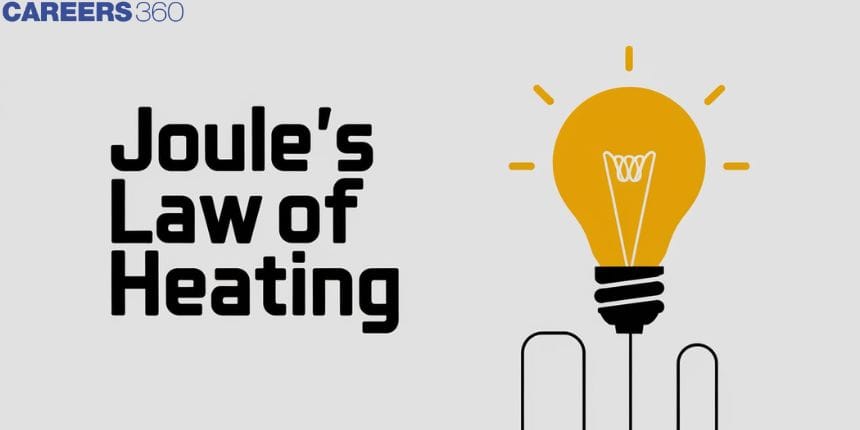Joule's Law Of Heating
Joule's Law of Heating is a fundamental principle in physics that explains how electrical energy is converted into heat energy when an electric current flows through a conductor. According to this law, the heat produced in a conductor is directly proportional to the square of the current, the resistance of the conductor, and the time for which the current flows. This principle is not just a theoretical concept but has practical applications in everyday life. For instance, the heating of electric appliances like toasters, irons, and heaters relies on this law. When you switch on a heater, the electrical energy passing through the resistance coils generates heat, warming up the surroundings. Joule's Law is also crucial in understanding how electrical energy losses occur in power lines, making it vital for efficient energy management in real-world applications.
This Story also Contains
- Joule's Law of Heating
- Solved Examples Based on Joule's Law of Heating
- Summary

Joule's Law of Heating
Joule's experiments conclusively established that heat is a form of energy. Spending a given amount of mechanical work, always the same amount of heat will be produced. It does not depend on what type of arrangement is used for doing mechanical work. The main aim of his investigations was to determine exactly the ratio between the work done and the quantity of heat produced.
Apparatus Used in Joule's Experiment
An insulated container has vanes
One paddle submerged in the liquid
A mass attached to the paddle through a pully and rope
A thermometer
Assumption
The friction between the pulley and the rope is negligible.
Procedure
A paddlewheel 2 was submerged in the heat-insulated vessel 1 to the walls of which vanes 3 were fastened, the vanes interfering with the motion of water due to the rotation of the paddle.
Now, when block G falls down, it will cause the rotation motion of the paddle, the block is connected to the paddle by means of a rope and pulley 5.
As the block falls through a distance Δh, the work done by it is equal to the decrease in the potential energy of the block.
Because of this work, the kinetic energy of the molecules of the fluid gets increased and the temperature rises. The heat liberated in the water-filled vessel is calculated from the rise in water temperature, measured with the help of a thermometer.
Importance of Joule’s Experiments
This experiment shows that heat is a form of energy.
The same amount of heat was always produced by spending a given amount of mechanical work. It does not depend on what type of arrangement is used for doing mechanical work.
It develops the relationship between Joule and Calories.
Whenever heat is converted into mechanical work or mechanical work is converted into heat, then the ratio of work done to the heat produced always remains constant. i.e. $J=\frac{W}{Q}$
This is Joule’s law and J is called the mechanical equivalent of heat.
Recommended Topic Video
Solved Examples Based on Joule's Law of Heating
Example 1: Joule's law gives the relation between
1) Kinetic energy and potential energy
2) Kinetic energy and electrical energy
3) Mechanical energy and heat energy
4) Both 1 and 3
Solution:
Joule's Law
When the water in a stream falls from height h, its potential energy is converted into heat and the temperature of water rises slightly.
Joule's law describes the relationship between mechanical energy and heat energy.
Hence, the answer is the option (3).
Example 2: A block of mass 100 g slides down on a rough horizontal surface. If the speed of the block decreases from 10m/s to 5m/s, then the thermal energy (in Joule) developed in the process is
1) 2.23
2) 2.75
3) 3.25
4) 3.75
Solution:
Joule's Law
$\begin{aligned} & W=J Q=m g h \\ & m g h=J(m c \cdot \Delta \theta)\end{aligned}$
wherein
$\mathrm{m}=$ Mass of water
$\mathrm{c}=$ Specific heat of water
$\Delta \theta=$ Temperature
Thermal energy produced = change in kinetic energy $=1 / 2 \mathrm{~m}\left(v_2^2-v_1^2\right)$
$=1 / 2 \times 0.1 \times(100-25)=3.75 \mathrm{~J}$
Hence, the answer is the option (4).
Example 3: A 100 g iron nail is hit by a 1.5 kg hammer striking at a velocity of $60 \mathrm{~ms}^{-1}$. What will be the rise in the temperature of the nail if one-fourth of the energy of the hammer goes into heating the nail?
[Specific heat capacity of iron = $=0.42 \mathrm{Jg}^{-1}{ }^{\circ} \mathrm{C}^{-1}$ ]
1) $675^{\circ} \mathrm{C}$
2) $1600^{\circ} \mathrm{C}$
3) $16.07^{\circ} \mathrm{C}$
4) $6.75^{\circ} \mathrm{C}$
Solution:
$
\begin{aligned}
& K E \text { of hammer }=\frac{1}{2} m v^2 \\
& =\frac{1}{2} \times 1.5 \times(60)^2 \\
& =\frac{3}{4} \times 3600 \\
& =2700 \mathrm{~J}
\end{aligned}
$
$
\begin{aligned}
& \text { Energy given to nail }=\frac{1}{4}(\mathrm{KE} \text { of hammer }) \\
& m C \Delta T=\frac{2700}{4} \\
& 100 \times 0.42 \times \Delta T=\frac{2700}{4} \\
& \Delta T=\frac{2700}{4 \times 42} \\
& \Delta T=16.07^{\circ} \mathrm{C}
\end{aligned}
$
Hence, the answer is the option (3).
Summary
Joule's Law of Heating demonstrates that heat is generated when electrical energy is converted through the flow of current in a conductor, with the heat produced being proportional to the square of the current, resistance, and time. Joule's experiments confirmed that heat is a form of energy and established the relationship between mechanical work and heat. This principle is crucial in various real-life applications, such as in heating appliances and understanding energy losses in power systems.
